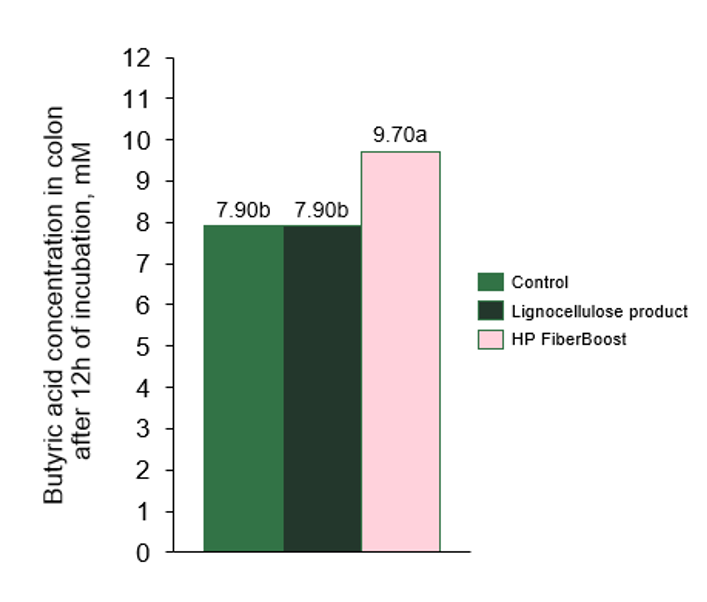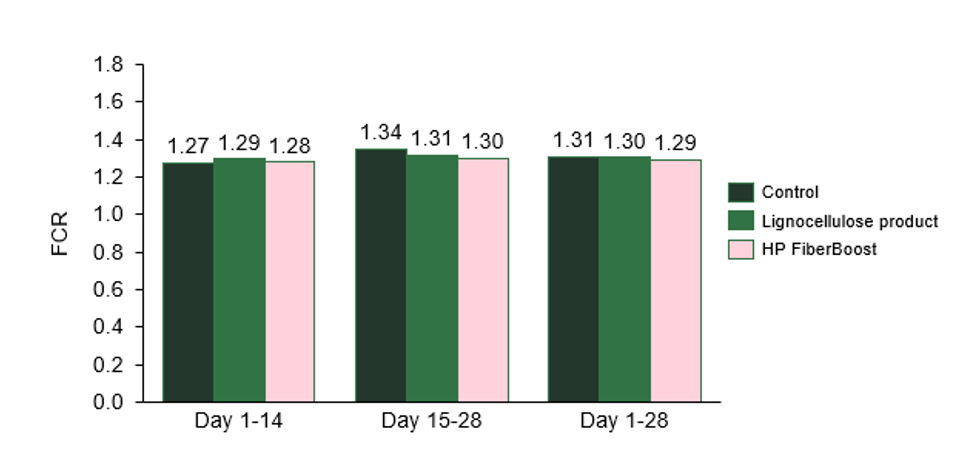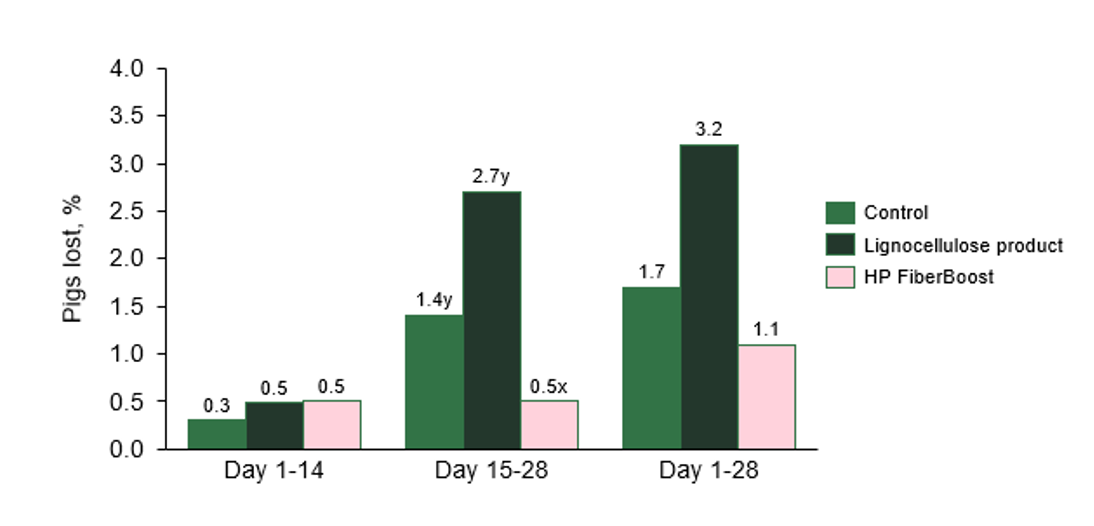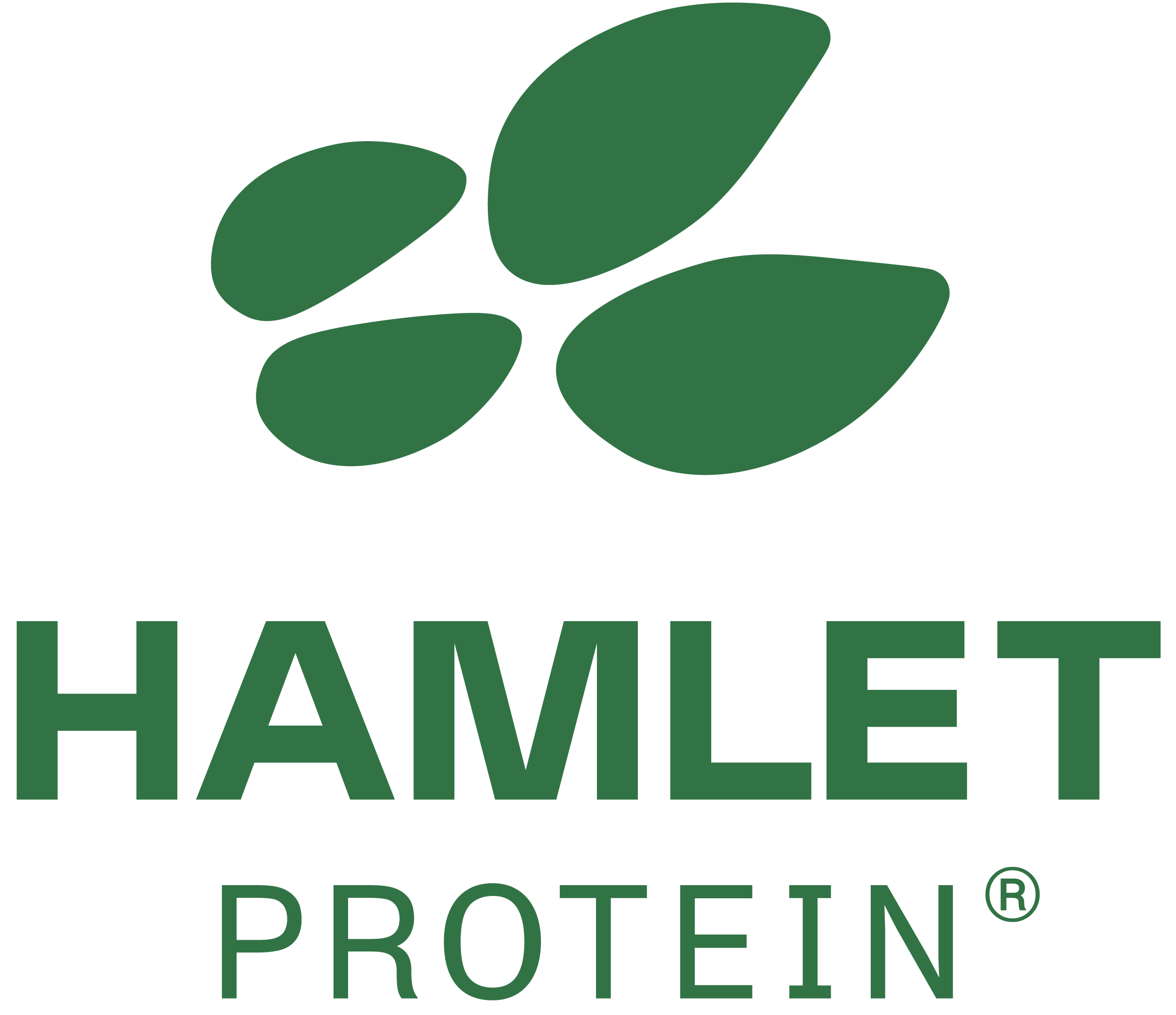



Using functional fiber to safeguard gut health after the ZnO ban – what have we learned so far?
Fiber, and especially functional fiber, plays an important role in the health and well-being of piglets. This has become more relevant with the ban on zinc oxide (ZnO) effective from end-June this year. As a response to the ZnO ban nutritionists started to reduce crude protein (CP) levels in the diet to mitigate the risk of post-weaning diarrhea (PWD). Other motives to use lower CP levels in nursery diets can be to reduce feed costs and to control nitrogen excretion into the environment.
However, reducing the crude protein content of nursery diets may be a costly decision as the risk exists that within the total amino acid (AA) absorption from a low CP diet some AA may fall under the required level for nursery pigs. It is, however, clear that without dietary changes maintaining the required CP levels to support optimal piglet growth becomes difficult as the high amount of protein can lead to protein fermentation in the hindgut and thus PWD. To avoid this from happening most measures are directed towards fixing the problem of pathogenic growth in the hindgut by means of antimicrobial or anti-inflammatory feed additives. At Hamlet Protein we believe it is more effective to eliminate the cause of this pathogenic growth; the undigested protein going to the hindgut where it is fermented by various pathogens. Reducing the amount of excess protein reaching the hindgut using highly digestible protein, free of anti-nutritional factors (ANF's) should be the first step. Improving the gut environment using prebiotic fibers is the second to support piglets’ resilience and gut health. This article provides an overview of what we have learned since we first started with our functional prebiotic fiber HP FiberBoost on the market.
What is functional fiber and why does it matter?
As described in previous articles (Navarro & van Leeuwen, 2022; Rasmussen, 2022), the concept of using fiber as a functional ingredient in nursery diets is gaining traction, since it induces physical and physiological benefits to the host by improving gut health (Jha et al., 2019). Soluble fibers and prebiotic carbohydrates (CHO’s) serve as substrate for microbiota residing in the hindgut that use it to produce short-chain fatty acids such as butyrate. In addition, the use of prebiotic CHO pushes protein fermentation down towards a more distal part of the colon since CHO is preferentially fermented by colon residing bacteria as it is more energetically favorable (Rowland et al., 2018). This results in a lower production of potentially harmful protein fermentation metabolites such as ammonia and indolic compounds which, in high concentrations, have detrimental effects on gut health (Pieper et al., 2016; Oliphant & Allen-Vercoe, 2019; Vasquez et al., 2022). The insoluble fibers exert their beneficial effect by having a physical effect in the gut stimulating peristaltic movements and reducing the adhesion of potential pathogenic bacteria to the gut wall (Molist et al., 2014).
In Hamlet Protein, we have conducted a series of trials with HP FiberBoost, a functional fiber that contains both soluble and insoluble fibers as well as prebiotic carbohydrates (CHO). Common to all trials is that HP FiberBoost exerts gut health preserving properties. Thirup et al. (2021) showed in an ex-vivo trial that the butyrate production increased by 23% and the concentration of branched-chain fatty acids (BCFA), a well-known indicator of protein fermentation (Williams et al., 2001; Louis & Flint, 2017), was lower when HP FiberBoost was incubated with colon digesta from weaning pigs (15 kg) for 12 hours compared to no added fiber and a lignocellulose product (figures 1 and 2). These results show that the presence of soluble fibers and prebiotic CHO’s in HP FiberBoost stimulates the production of beneficial metabolites such as butyrate and reduces the fermentation of protein. Since hindgut fermentation of protein is associated with the presence of potentially harmful bacteria, results further suggest that HP FiberBoost can induce competitive exclusion of potential pathogenic bacteria in the hindgut. Growth of more favorable microbiota safeguards gut health and therefore also (future) performance of the newly weaned piglet.
The effect of HP FiberBoost on the production of short chain fatty acids (SCFA) was confirmed in-vivo (Saliu et al., 2022). The concentration of SCFA was increased in piglets supplemented with HP FiberBoost, indicating that the gut microbiome was modulated by the addition of HP FiberBoost. These modulations suggest a gut health promoting effect of HP FiberBoost. Question now is, does this gut health effect also correspond to improved performance on farm?

Figure 1 Concentration (mM) of the short-chain fatty acid (SCFA) butyric acid in colon digesta after 12 hours of incubation with no added fiber (control), HP FiberBoost or a lignocellulose product (Thirup et al., 2021).

Figure 2 Concentration of branched-chain fatty acids (BCFA, % of total SCFA) in colon digesta after 12 hours of incubation with no added fiber (control), a lignocellulose product or HP FiberBoost (Thirup et al., 2021).
Functional fiber – on farm
No two farms are the same and the same is true for their nursery diets. Many feed complex nursery diets containing various feed additives to ease the transition from the highly digestible sow milk to a vegetable based solid feed after weaning. It is, however, very well possible to feed simpler, clean diets if the right high-quality ingredients are used. Rasmussen et al. (2022) fed weanling pigs either a complex diet with various gut health promoting feed additives (control) or a simpler diet without the feed additives but with additional fiber from a source of insoluble fiber (lignocellulose based) or a source that combined both soluble and insoluble fiber (HP FiberBoost). No difference was observed on piglet growth performance (figure 3) between the three diets. This shows that increasing the fiber content of the diet did not compromise performance, thus corroborating the findings of Saliu et al. (2022). In addition, pigs fed the HP FiberBoost diet were more resilient evident by fewer pigs lost (figure 4) compared to the lignocellulose product and the complex control diet.

Figure 3 Feed conversion rate (FCR) of pigs when either fed a complex diet with various gut health promoting feed additives (control) or a simple nursery diet with a lignocellulose product or HP FiberBoost. Reference: (Rasmussen et al., 2022).

Figure 4 Pigs lost (mortality+removals, %) when either feeding a complex diet with various gut health promoting feed additives (control) or a simple nursery diet with a lignocellulose product or HP FiberBoost. x,y indicate a near-significant trend (p<0.10). Reference: (Rasmussen et al., 2022).
As mentioned before a common response to reduce PWD in the post ZnO era is to lower the crude protein level of nursery diets. As already pointed out, lowering the crude protein level of the diet comes at a cost in terms of reduced performance as FCR increases immediately when one of the AA’s falls below the minimum requirement. This was clearly demonstrated in a recent trial (2022, data not published). Reducing crude protein levels from 19 to 17% reduced piglet growth performance significantly, leading to increased FCR of 1.42 at 17% CP vs 1.34 at 19% CP (see table 1). This immediately affects feed costs negatively. Margin over feed costs was reduced with 2.70 euros per pig when protein levels were reduced from 19 to 17%.
In the same trial, it was tested whether the addition of a functional fiber source (HP FiberBoost) would support keeping a high protein level in the diets. Growth and feed conversion rate were similar for pigs fed the high protein diet without or with HP FiberBoost added, but a trend (p=0.06) towards lower mortality was observed for the addition of HP FiberBoost. Furthermore, the addition of HP FiberBoost resulted in a 1.6 points improvement in uniformity of the piglets fed high protein levels. These benefits improved the margin over feed costs with 1.40 euros per pig for high CP + HP FiberBoost vs high CP without HP FiberBoost. It can be concluded that it is very well possible to keep high protein levels and good performance in nursery diets without ZnO when HP FiberBoost is added to the diet. The overall reduction in margin over feed costs were 4.10 euros per pig when protein levels were reduced compared to the high CP + HP FiberBoost group.
Table 1 Performance at day 41 post-weaning of pigs fed a control diet (19% CP, no added fiber) or a diet containing 4% HP FiberBoost.
Variable |
Dietary treatment |
SEM |
P-value |
||||
17% CP, no fiber |
17% CP+ HP FiberBoost |
19% CP, no fiber |
19% CP+ HP FiberBoost |
||||
N, pens |
14 |
14 |
14 |
14 |
|||
BW d0 |
5.04 |
5.04 |
5.05 |
5.04 |
0.289 |
1.000 |
|
BW d41 |
18.68b |
18.81b |
20.58a |
20.58a |
0.183 |
<0.001 |
|
ADG, kg/d |
0.333b |
0.336b |
0.379a |
0.379a |
0.0045 |
<0.001 |
|
ADFI, kg/d |
0.442c |
0.456bc |
0.477ab |
0.484a |
0.0068 |
<0.001 |
|
FCR, kg/kg |
1.422a |
1.418a |
1.340b |
1.347b |
0.0084 |
<0.001 |
|
Mortality rate, % |
6.59 |
1.65 |
5.49 |
3.85 |
0.13* |
||
Uniformity, CoV, % |
11.78 |
11.24 |
11.56 |
9.94 |
0.735 |
0.23* |
|
Note: ADG = average daily gain; ADFI = average daily feed intake; FCR = feed conversion ratio; Uniformity calculated as coefficient of variation (CoV; mean/sd*100). a,b,c indicate significant differences (p<0.05) between the experimental groups. *Mortality rate: main effect of HP FiberBoost addition is a near-significant trend (p=0.06); Uniformity: for main effect of HP FiberBoost addition p=0.15. |
|||||||
The outcomes of the above described trials confirm that the addition of HP FiberBoost to nursery diets results in more resilient piglets, which is due to the combination of soluble and insoluble fiber that stimulate microbial fermentation and exert a physical effect in the gastrointestinal tract, respectively. Consequently, pigs may indeed have a basal requirement for fiber – and results summarized in this article, suggests that pigs do not only need insoluble fiber but also has a requirement for soluble fiber as well to stimulate microbial fermentation in the hindgut.
In conclusion, the functional fiber source HP FiberBoost allows for the formulation of clean nursery diets with a high protein content to maintain a good performance level and favorable ROI in the post ZnO era. The use of HP FiberBoost serves as an ‘insurance’ during the challenging weeks after weaning by safeguarding gut health through microbial fermentation with more resilient and uniform piglets as result.
| References | ||||
|---|---|---|---|---|
| Jha, R.; Fouhse, J. M.; Tiwari, U. P.; Li, L.; Willing, B. P., | ||||
| (2019) | Dietary fiber and intestinal health of monogastric animals. Frontiers in Veterinary Science. | 6, 1–12. | ||
| Louis, P.; Flint, H. J., | ||||
| (2017) | Formation of propionate and butyrate by the human colonic microbiota.. Environmental Microbiology. | January 8: | ||
| Molist, F.; van Oostrum, M.; Pérez, J. F.; Mateos, G. G.; Nyachoti, C. M.; van der Aar, P. J., | ||||
| (2014) | Relevance of functional properties of dietary fibre in diets for weanling pigs.. Animal Feed Science and Technology., | 189, 1–10. | ||
| Navarro, D.; van Leeuwen, J., | ||||
| (2022) | Why fiber matters. | The Pig Site. | ||
| Oliphant, K.; Allen-Vercoe, E., | ||||
| (2019) | Macronutrient metabolism by the human gut microbiome: Major fermentation by-products and their impact on host health.. Microbiome., | 7. | ||
| Pieper, R.; Villodre Tudela, C.; Taciak, M.; Bindelle, J.; Pérez, J. F.; Zentek, J., | ||||
| (2016) | Health relevance of intestinal protein fermentation in young pigs.. Animal Health Research Reviews., | 17, 137–147. | ||
| Rasmussen, S. H., , | ||||
| (2022) | Are you choosing the right fiber source? | The Pig Site. | ||
| Rasmussen, S. H.; van Leeuwen, J.; Dubberke, G., | ||||
| (2022) | Effect of two sources of dietary fiber on health and performance of weanling pigs. | Zero Zinc Summit. Copenhagen. | ||
| Rowland, I.; Gibson, G.; Heinken, A.; Scott, K.; Swann, J.; Thiele, I.; Tuohy, K., | ||||
| (2018) | Gut microbiota functions: metabolism of nutrients and other food components. | European Journal of Nutrition. | ||
| Saliu, E. M.; Rasmussen, S. H.; van Leeuwen, J.; Zentek, J., | ||||
| (2022) | The impact of adding different levels of enzyme-treated soy fibre to weaners diets on performance and short chain fatty acid production in the hindgut. | 15th International Symposium on Digestive Physiology of Pigs. Animal - Science Proceedings, p. 200. | ||
| Thirup, L.; Rasmussen, S. H.; Apajalahti, J.; Rinttila, T.; Brøkner, C., | ||||
| (2021) | Ex-vivo gas- and organic acid production when incubating fiber products with colon inoculum from weaned piglets. | 75. | Tagung der Gesellschaft für Ernährungsphysiologie (GfE)., p. Abstract 115. | |
| Vasquez, R.; Oh, J. K.; Song, J. H.; Kang, D. K., | ||||
| (2022) | Gut microbiome-produced metabolites in pigs: a review on their biological functions and the influence of probiotics.. Journal of Animal Science and Technology., | 64, 671–695. | ||
| Williams, B. A.; Verstegen, M. W. A.; Tamminga, S., | ||||
| (2001) | Fermentation in the large intestine of single-stomached animals and its relationship to animal health.. Nutrition Research Reviews., | 14, 207–227. |










